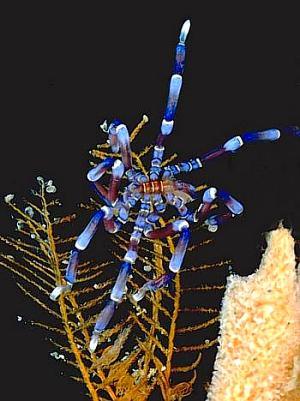
Sea slug predators - Pycnogonids (Sea Spiders)
PHOTO
Pycnogonid, Anoplodactylus evansi. Coffs Harbour Region, northern New South Wales, Australia, Dec 1990. (Leg length = 15mm). PHOTO: Bill Rudman.
Anoplodactylus evansi is a generalist predator of small opisthobranchs, and is reported to attack and feed on small individuals of at least 13 species of anaspidean, sacoglossan and nudibranch gastropods, as well as other soft-bodied invertebrates (Rogers, de Nys, & Steinberg, 2000). It hunts opisthobranchs on benthic algae, immobilizing them with movable claws on the front legs, before consuming them. It eats whole opisthobranchs, including the nudibranchs Bornella stellifer, Austraeolis ornata Angas, 1864, and Spurilla australis Rudman, 1982. Another species, Anoplodactylus carvalhoi has been reported to only eat nudibranch cerata (Piel, 1991).
One of its main food items are juvenile Sea Hares and a recently published report (Cary, et al, 2000) investigated whether the diet-derived compounds in the Sea Hare Aplysia parvula acted as a deterrent against attack. Anoplodactylus evansi was not deterred from feeding on A. parvula by the diet-derived secondary metabolites from the red seaweeds Laurencia obtusa or Delisea pulchra. However, increasing the quantity of metabolites present in A. parvula by treatment with adult extracts did deter A. evansi from feeding, suggesting that high levels of diet-derived materials in sea hares may have deterrent effects against a predator. Aplysia parvula stores the bulk of its acquired algal secondary metabolites in its digestive gland, so pycnogonids would avoid exposure to high concentrations by rejecting this organ, and pycnogonids were sometimes observed rejecting the digestive gland when feeding on Sea Hares.
Although Anoplodactylus evansi has been collected at several sites along the New South Wales coastline, and as far south as Tasmania, its local distribution seems to be very patchy. This is probably a result of its reproductive behaviour in which it broods its young, limiting dispersal to nearby seaweeds. This leads to resident populations of pycnogonids occurring at particular localities. Over a number of years Aplysia parvula was significantly less abundant on the red alga Laurencia obtusa at sites where there was a resident population of the pycnogonid.
Anoplodactylus evansi is able to tolerate low levels of secondary metabolites and feed successfully on a wide variety of small opisthobranchs with different defensive substances. The opisthobranchs investigated here are known to sequester different metabolites and juvenile Aplysia parvula which contained secondary metabolites from the algae Laurencia obtusa or Delisea pulchra, were consumed nonetheless. This pycnogonid can apparently tolerate a variety of secondary metabolites in its diet, including compounds found in sponges, cnidarians, bryozoans, as well as opisthobranchs.
References:
• Rogers, C.N., de Nys, R. & Steinberg, P.D. (2000) Predation on juvenile Aplysia parvula and other small Anaspidean, Ascoglossan and Nudibranch Gastropods by Pycnogonids. The Veliger, 43(4): 330-337.
• Piel, W. H. 1991. Pycnogonid predation on nudibranchs and ceratal autotomy. The Veliger, 34:366-367.
See following relevant messages from:
Cary Rogers and Jen Whitacre.
Rudman, W.B., 2001 (January 7) Sea slug predators - Pycnogonids (Sea Spiders). [In] Sea Slug Forum. Australian Museum, Sydney. Available from http://www.seaslugforum.net/factsheet/pycnogon
